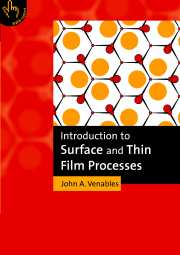Book contents
- Frontmatter
- Contents
- Preface
- Chapter 1 Introduction to surface processes
- Chapter 2 Surfaces in vacuum: ultra-high vacuum techniques and processes
- Chapter 3 Electron-based techniques for examining surface and thin film processes
- Chapter 4 Surface processes in adsorption
- Chapter 5 Surface processes in epitaxial growth
- Chapter 6 Electronic structure and emission processes at metallic surfaces
- Chapter 7 Semiconductor surfaces and interfaces
- Chapter 8 Surface processes in thin film devices
- Chapter 9 Postscript – where do we go from here?
- Appendix A Bibliography
- Appendix B List of acronyms
- Appendix C Units and conversion factors
- Appendix D Resources on the web or CD-ROM
- Appendix E Useful thermodynamic relationships
- Appendix F Conductances and pumping speeds, C and S
- Appendix G Materials for use in ultra-high vacuum
- Appendix H UHV component cleaning procedures
- Appendix J An outline of local density methods
- Appendix K An outline of tight binding models
- References
- Index
Appendix G - Materials for use in ultra-high vacuum
Published online by Cambridge University Press: 06 July 2010
- Frontmatter
- Contents
- Preface
- Chapter 1 Introduction to surface processes
- Chapter 2 Surfaces in vacuum: ultra-high vacuum techniques and processes
- Chapter 3 Electron-based techniques for examining surface and thin film processes
- Chapter 4 Surface processes in adsorption
- Chapter 5 Surface processes in epitaxial growth
- Chapter 6 Electronic structure and emission processes at metallic surfaces
- Chapter 7 Semiconductor surfaces and interfaces
- Chapter 8 Surface processes in thin film devices
- Chapter 9 Postscript – where do we go from here?
- Appendix A Bibliography
- Appendix B List of acronyms
- Appendix C Units and conversion factors
- Appendix D Resources on the web or CD-ROM
- Appendix E Useful thermodynamic relationships
- Appendix F Conductances and pumping speeds, C and S
- Appendix G Materials for use in ultra-high vacuum
- Appendix H UHV component cleaning procedures
- Appendix J An outline of local density methods
- Appendix K An outline of tight binding models
- References
- Index
Summary
This appendix gives a few indicators of suitable materials for use in a UHV environment. The main point is simply to emphasize that the materials need to have low outgassing rates per unit area exposed, and that they need to be stable at the temperatures not only of use, but also during bakeout. Some of the obvious candidates in the different categories are as follows. Much of this information can be gleaned from talking to practitioners, from vacuum technology books such as Dushman & Lafferty (1992), O'Hanlon (1989), Roth (1990) or from reading between the lines in design handbooks such as Yates (1997), or increasingly from the web. A page giving properties and some sources for materials is at http://venables.asu.edu/grad/ appmat1.html
Structural materials
The most widely used structural material is 304 stainless steel, which is used to make chambers, flanges, etc., and can also be used for stages and other parts of the experiment itself. At very low temperatures this austenitic (largely f.c.c.) 18–20%Cr, 8–10%Ni Fe-based alloy transforms in part to the b.c.c. (martensitic) structure, and thereby becomes magnetic. If this could be important, then more technical details are needed, such as would be obtained from ASSDA – the Australian Stainless Steel Development Association – or AVS – the American Vacuum Society. Aluminum alloys are used for experimental pieces inside the vacuum system, and have also been used for whole chambers on occasion.
- Type
- Chapter
- Information
- Introduction to Surface and Thin Film Processes , pp. 320 - 322Publisher: Cambridge University PressPrint publication year: 2000

